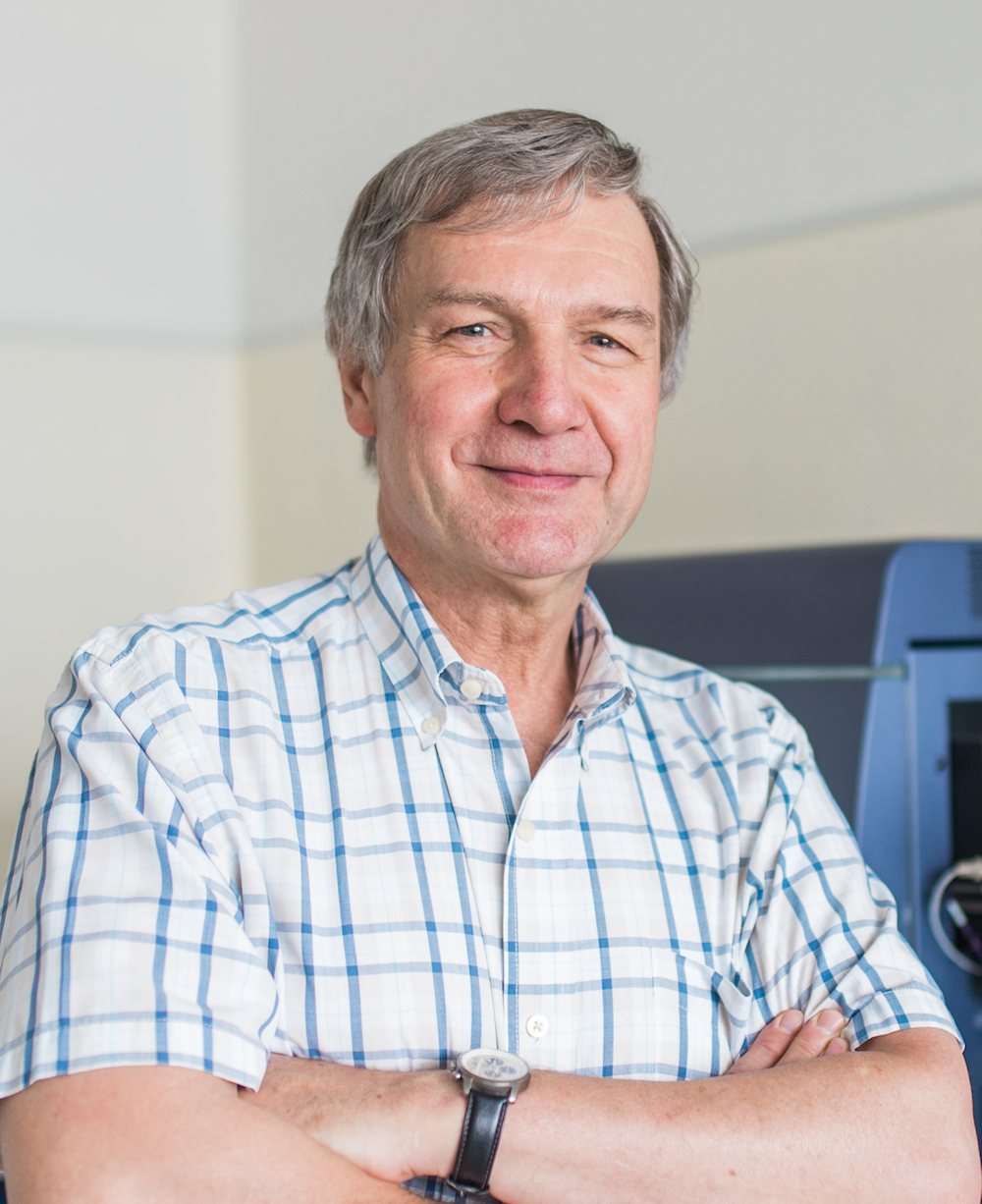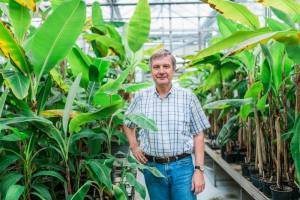Jaroslav Doležel has been involved in the efforts to sequence the wheat genome since before the birth of the IWGSC, as his team pioneered flow sorting of wheat chromosomes and constructed the first BAC library of a wheat chromosome in 2002. When the IWGSC was created in 2005, the consensus was that the only way to tackle the complexity of the wheat genome was to use a chromosome by chromosome strategy. Over the next 12 years, Jaroslav’s team optimized the procedure and relentlessly worked on the production of 45 chromosome – or chromosome-arm – specific BAC libraries for the 21 wheat chromosomes.
When the illumina sequencing technology became accessible, they prepared DNA from wheat chromosome arms for sequencing, which enabled the delivery of a draft survey sequence (chromosome survey sequence, or CCS) that was published by IWGSC in the journal Science in July 2014. In August 2018, the IWGSC published the reference sequence of the bread wheat genome in Science, an accomplishment that would not have been possible without the dedication, commitment and extensive work of Jaroslav and his team.
Earlier this year, at the Plant and Animal genome Conference in San Diego, we had the chance to sit down with Jaroslav and chat about his experience with the IWGSC, his current research projects, and his next challenges.
You have been involved with the IWGSC since the beginning, how would you describe this experience?
It was an absolutely unique experience in which I was very lucky to be involved. As a scientist, it linked me with so many different colleagues I would have never have worked with otherwise. It also brought me to a completely different level, from a local central European environment, to a global environment. Me, my colleagues, and the students in my lab were working with top researchers across the world – real “stars” – leading scientists from bioinformatics, genomics, breeding, and this brought a huge benefit for us. It pushed us forward. Suddenly, we became experts in many areas because we were discussing with these colleagues, it raised us all up in an incredible way.
I had been involved in other consortia before, but wheat was unique because of the professional management by Kellye Eversole and the office; it was a completely different level of management. I think that the scientific environment and the professional management & coordination were key to the success. I also enjoyed the feeling of working on something really important as wheat, participating in a global project with a global impact.
It had some impact in my country as well, because once results started coming, we were recognized, people noticed us, and this led to our involvement in international collaborative projects. Also, this helped us financially as well because we were obviously trying to contribute to the goals of the consortium and most of the work was funded with our own funding. Our projects would not have been funded if there had not been a consortium.
I was so lucky to be part of this experience, it means a lot to me, personally and scientifically.
The RefSeq project has now almost reached its end, what would you say were the main challenges or roadblocks along the way?
When the project started, the challenges were clear: huge genome and polyploidy, which we now know how to manage but did not know at that time. At the time, the key to unlocking this challenge was to use the chromosomes. I still remember clearly all the discussions about the strategies at PAG and the moment it was decided to go with chromosomes. I believe this was the best strategy at the time - there was no long read sequencing technology, there was no high throughput sequencing technology, there was no Illumina. It was definitely the best approach and it was done well, and it is still useful as you can go back to those resources, they will always be there. Even in human genomics, people find BAC libraries useful. Along the way, new technologies came along and were integrated in the IWGSC strategy. It is different now, and it is logical to start with whole genome sequencing and to use chromosome sequencing after to validate the sequence.
Currently the most frequent and most rewarding applications of flow sorted chromosomes are projects on gene cloning. Together with Brande Wulff and his team at JIC Norwich, we have developed so called MutChromSeq approach that has been used successfully to clone several important wheat genes. The second powerful gene cloning approach called targeted chromosome-based cloning via long-range assembly (TACCA) was developed with Simon Krattinger, at that time at the University of Zurich. So we do continue delivering to wheat genetics, genomics and breeding.
Based on your experiences in other sequencing projects, what would you say makes in international consortium successful?
You need a certain level of management and control. Otherwise, there is always private interest, so people collaborate only when it is profitable for them, but it may not be the most efficient way. Self-management may work with smaller projects, but this cannot work with large projects like wheat.
What do you think should be the role of the IWGSC in the future?
Now it’s looser, and this was expected, because we no longer have one common goal.
The main role for the consortium should be to maintain and improve the resources, to coordinate the annotation and the incorporation of new results obtained, for example by re-sequencing many other cultivars and epigenome profiling. Maintaining all the databases is crucial and it should be done efficiently and in centralized way. I realize that funding for such coordinating activities is not easy to find. But it would be a real pity to stop now, the work has not been completed, it’s only the first step.
You are working on several plant projects, which one is the most interesting/challenging/rewarding to you right now, why?
I must admit that I love banana. It’s challenging, it’s difficult, and it’s important. It’s shocking how little research is done on banana which is such an important crop. We were lucky in wheat because breeding companies contributed, this was not the case in banana until recently. There is so little done that you feel that you can really make a difference there.
We were the first to introduce flow cytometry in banana breeding. Now, banana breeders are using the method to screen for ploidy, a key technology as banana plants have different ploidies, so you need to know what you obtain when you cross them.
We were among the first labs to establish molecular cytogenetics in banana, and we also participated to the genome sequencing project through a collaboration with CIRAD in Montpellier, France. A very rewarding activity was genotyping of the global gene bank in Leuven, Belgium, which led us to be involved in a large project of the International Institute of Tropical Agriculture on the improvement of banana in the Great Lakes Region of Africa, which is funded by Bill & Melinda Gates Foundation.
Currently we are involved in genome sequencing activities, and are the first lab that sequenced the triploid plantain and we are sequencing other types of “cooking bananas”, which provide a staple food for millions in Africa. I should add that I love Africa; I don’t know why.
Is there a plant genome you would love to work on?
In don’t know, we currently work on sugarcane – a very complicated genome – where we do chromosome sorting; we have also contributed to the pea genome sequence which is being published. Maybe garlic. I worked on this seed-sterile species during my PhD study and now I have a new collaboration with Korea, and I hope that together we will sequence the garlic genome.
But the real scientific challenge now is to study the three-dimensional organization of the genome as you cannot explain the function of a genome without knowing its structural organization and long-range interactions of DNA loci. This is where we are moving towards in our research Centre and we plan on working at different levels, from the DNA level up to the chromosome level.
You recently received the most prestigious scientific prize in the Czech Republic – dubbed the Czech Nobel prize – what impact will that have on your work?
It’s a huge recognition and still hasn’t sunk in. It definitely had an impact, everybody knows about the award and it has clearly opened doors. Our Centre, for example, has gained an increased visibility.
As a scientist, I have this motor inside that keeps me going on, I don’t do it for money or recognition. I liked having the Science and Nature papers of course, but this is not the goal, the goal is to know and do something that is really useful. That’s a good feeling. The papers are awards. The primary motivation for me is to contribute. I’m lucky for doing what I do.
About Jaroslav
Jaroslav Doležel obtained his MSc. degree from the University of Agriculture in Brno in 1978 and his PhD degree from the Institute of Experimental Botany (IEB), Czechoslovak Academy of Sciences in 1983. He obtained his DSc. degree from the Czech Academy of Sciences (the CAS) in 2001. He was appointed Associate Professor at Palacký University in Olomouc in 2001 and Professor of Molecular Biology and Genetics in 2013.
Jaroslav’s research focuses on plant genome structure, function and evolution, and the application of flow cytometry to analyze nuclear genome, genome mapping and sequencing in economically important crops. He pioneered chromosome genomics to facilitate the analysis of complex and polyploid genomes, including hexaploid bread wheat. Jaroslav has published more than 300 papers in scientific journals, edited three books and was principal investigator and co-investigator in more than thirty national and international research projects. He is a member of the Learned Society of the Czech Republic and has received several prestigious awards for his scientific achievements, the latest being the Czech Mind prize – in 2018 – a prize nicknamed the “Czech Nobel Prize”.
Publication date: 06/28/2019


